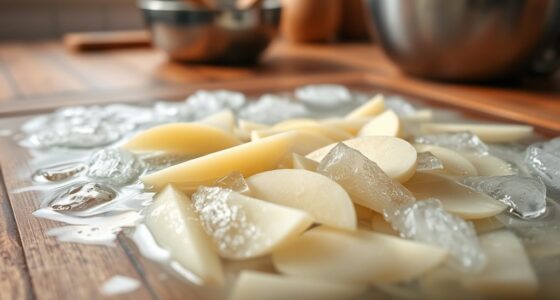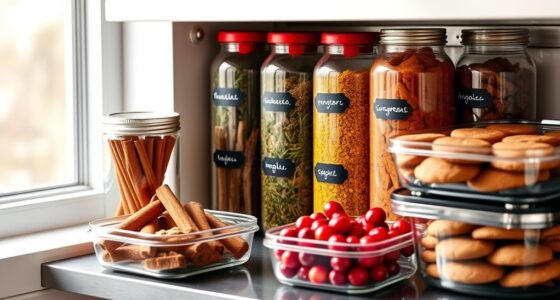Understanding the role of pH levels in food can unlock a new world of flavor and preservation. From ancient pickling to modern processing, acidity shapes color, texture, and shelf-life. As a cook, you'll learn to leverage pH for creating balanced, vibrant dishes. Pair acidic ingredients with neutral or alkaline foods to find the perfect flavor harmony. Experimentation is key – adjust seasoning, cooking methods, and chill times to enhance natural flavors. With a bit of practice, you'll develop an intuitive feel for how acidity transforms the culinary experience. There's more to explore when it comes to the science of pH in the kitchen.
Key Takeaways
- pH levels in food influence color, texture, and shelf-life, driving the evolution of food processing and preservation methods.
- Acidity affects flavor, with tart dishes balanced using baking soda or sugar, and experimentation leading to the perfect pH-adjusted seasoning.
- Soaking ingredients in acidic mediums, like vinegar or citrus juice, tenderizes, enhances sweetness, and prevents oxidation for a balanced dish.
- Baking soda can neutralize excessive acidity, balancing flavors, tenderizing meats, and enhancing rise in baked goods.
- Chilling enhances flavors and textures, with final adjustments ensuring a well-rounded and enjoyable culinary creation through experimentation.
History
The concept of pH levels in food has long been a subject of interest and study. For centuries, humans have recognized the importance of acidity in various culinary applications, from preserving foods to enhancing flavors. Ancient civilizations, such as the Egyptians and Chinese, were known to use fermentation and pickling techniques that relied on the regulation of pH levels.
Throughout history, advancements in chemistry and food science have provided a deeper understanding of the relationship between pH and food properties. Researchers have explored how pH influences the color, texture, and shelf-life of different food items, leading to the development of more precise methods for controlling and monitoring acidity.
This knowledge has been crucial in the evolution of food processing, preservation, and culinary practices, enabling chefs and food scientists to harness the power of pH to create more delectable and stable food products.
Recipe
Cooking a delicious and well-balanced meal isn't only a matter of taste but also considering the pH levels of the ingredients. This recipe for a perfectly pH-balanced dish showcases how you can create a satisfying and nutritious culinary experience. Incorporating ingredients with natural properties can enhance the meal's health benefits, similar to how essential oils provide natural antibacterial and antifungal properties.
The key to this recipe is the careful selection of ingredients that complement each other's pH levels, resulting in a harmonious blend of flavors and a meal that's gentle on your digestive system.
- 2 cups of quinoa
- 1 cup of diced bell peppers (a mix of red, yellow, and green)
- 1 cup of chopped kale
- 1/2 cup of sliced mushrooms
- 1/4 cup of slivered almonds
- 2 tablespoons of olive oil
- 1 tablespoon of lemon juice
- 1 teaspoon of sea salt
- 1/2 teaspoon of black pepper
In a large saucepan, bring 4 cups of water to a boil. Add the quinoa, cover, and reduce the heat to low. Simmer for 15-20 minutes, or until the quinoa is fluffy and the water has been absorbed. Fluff the quinoa with a fork and let it cool slightly.
In a large mixing bowl, combine the cooked quinoa, diced bell peppers, chopped kale, sliced mushrooms, and slivered almonds. Drizzle the olive oil and lemon juice over the ingredients, and season with sea salt and black pepper. Gently toss the salad until all the ingredients are evenly distributed.
This pH-balanced quinoa salad is a versatile and nutritious dish that can be enjoyed as a main course or a side. The combination of alkaline-forming vegetables, acidic lemon juice, and neutral quinoa creates a harmonious balance that will leave you feeling satisfied and energized.
Cooking Steps
First, soak your ingredients in an acidic medium like vinegar or lemon juice to help balance the pH.
Next, heat the mixture to further adjust the pH.
Step 1. Soak Ingredients in Acidic Medium

Soaking your ingredients in an acidic medium can significantly impact their texture and flavor. By immersing foods like meat, vegetables, or grains in an acidic solution, you can tenderize tough cuts, enhance sweetness, and even preserve the freshness of your ingredients. The acidity in the medium helps break down tough fibers and proteins, making them more tender and easier to chew. This process is particularly useful for hearty root vegetables or tough cuts of meat.
Moreover, the acidity can help preserve the vibrant colors of certain foods, such as berries or leafy greens, by preventing oxidation. Additionally, soaking in an acidic solution can draw out unwanted flavors or bitterness, resulting in a more balanced and harmonious dish.
Whether you're using vinegar, citrus juice, or even yogurt, the key is to find the right balance of acidity to suit your recipe. Experiment with different acidic mediums and soak times to discover the perfect flavor profile for your dish.
Step 2. Heat Ingredients

Once you have properly soaked your ingredients, the next step is to heat them. Proper heating is crucial for developing the desired flavors and textures in your dish. Whether you're sautéing, simmering, or roasting, the way you apply heat can significantly impact the final outcome.
Start by choosing the right cooking method for your ingredients. For example, delicate herbs and vegetables may benefit from a gentle simmer, while heartier meats and root vegetables can withstand higher heat for roasting or searing.
Pay close attention to the temperature and duration of the cooking process, as overcooking can lead to undesirable changes in pH levels and flavor.
As you heat the ingredients, be mindful of the interactions between the food and the cooking medium, such as water, oil, or acidic liquids. These interactions can further influence the pH, texture, and overall character of the dish.
Adjust the heat and cooking time as needed to strike the perfect balance and bring out the best in your ingredients.
Step 3. Adjust Ph With Baking Soda

Adjusting the pH of your dish with baking soda can be a powerful technique to balance flavors and textures. By adding a small amount of baking soda, you can neutralize acidic ingredients and create a more harmonious taste.
This method is particularly beneficial when working with certain ingredients that can overwhelm a dish's profile, such as tomatoes or citrus, which can lead to an unbalanced flavor experience. Start by determining the pH level of your dish. If it's too acidic, a pinch of baking soda can help.
Add it slowly, stirring and tasting as you go, to avoid overshooting the desired pH. This is especially useful for taming the tartness of tomatoes, vinegar, or citrus. But be careful – too much baking soda can make your dish taste metallic or soapy. It's a delicate balance.
You can also use baking soda to tenderize tough meats or enhance the rise in baked goods. Experiment and pay attention to the changes in texture and flavor.
Adjusting the pH with baking soda is a simple yet effective way to fine-tune your culinary creations. For more insights on the impact of acidity in cooking, check out this cold medications overview.
Step 4. Chill Mixture Before Serving

After adjusting the pH of your dish with baking soda, the next step is to chill the mixture before serving. Lowering the temperature can help enhance the flavors and textures of your food.
Incorporating gentle stretching or relaxation techniques into your cooking routine can further improve your culinary experience by reducing tension and enhancing focus.
Start by transferring the mixture to a chilled bowl or container. If it's a thick dish, like a sauce or dip, you may want to place it in the refrigerator for 30 minutes to an hour. This will allow the flavors to meld and the texture to thicken up.
For lighter dishes, like salads or beverages, 10-15 minutes in the fridge should do the trick. Pay close attention, as you don't want to over-chill the mixture and risk it becoming too firm or losing its desired consistency.
When you're ready to serve, give it a gentle stir and enjoy the perfectly balanced, chilled dish. Chilling your food before serving helps to round out the flavors and creates a more enjoyable dining experience.
Step 5. Taste and Adjust Seasoning

Next, taste your dish and make any necessary seasoning adjustments. The pH level of your ingredients can significantly impact the overall flavor profile.
If the dish tastes flat or one-dimensional, it may need a boost in acidity. Try adding a splash of vinegar, a squeeze of lemon or lime juice, or a pinch of citric acid powder.
Conversely, if the dish is overly tart or sour, you can balance it by incorporating a small amount of baking soda or a pinch of sugar.
Taste as you go, making incremental changes until you achieve the desired flavor balance. Remember, the goal is to enhance the natural flavors of your ingredients, not to mask them. This process requires patience and a keen understanding of the ingredients you are working with. It’s important to take into account the role of microbiology in fermentation, as it can greatly impact the flavor development of your dish. By carefully monitoring the fermentation process, you can ensure that the natural flavors are allowed to shine through, resulting in a truly exceptional end product.
Pay close attention to how the pH adjustments affect the other seasonings and make further tweaks as needed. With a little experimentation, you'll be able to find the perfect pH-adjusted seasoning that brings out the best in your dish.
Final Thoughts
While the pH levels in various foods may seem daunting at first, keeping a few key points in mind can help you make informed choices.
Remember, acidity isn't inherently good or bad – it's about understanding how it affects the flavor, texture, and preservation of the foods you enjoy.
Embrace the diversity of pH levels in your diet. Experimentation is the spice of life when it comes to cooking!
Try pairing acidic ingredients like citrus or vinegar with more neutral or alkaline foods to strike the right balance. Don't be afraid to taste and adjust as you go. With a little practice, you'll develop an intuitive feel for how pH influences the overall experience.
Most importantly, have fun in the kitchen. Cooking is an opportunity to explore, learn, and nourish yourself and your loved ones.
Frequently Asked Questions
What Is the Ideal Ph Range for Different Food Categories?
The ideal pH range varies for different food categories. Generally, acidic foods like fruits and vinegar-based condiments have a lower pH, while neutral or alkaline foods like meats and vegetables prefer a higher pH. Understanding this range is crucial for flavor and preservation.
How Can Ph Impact the Shelf Life of Food Products?
pH can significantly impact a food's shelf life. Higher acidity (lower pH) inhibits microbial growth, extending freshness. But extreme pH disrupts enzymes and degrades nutrients, shortening shelf life. Finding the optimal pH balances preservation with quality.
What Are the Common Ph-Adjusting Ingredients Used in Cooking?
Common pH-adjusting ingredients used in cooking include vinegar, lemon juice, baking soda, and cream of tartar. These can be used to alter the acidity or alkalinity of dishes, impacting their flavor and preservation.
Can Adjusting Ph Help Reduce the Use of Preservatives?
Adjusting the pH of your food can help reduce the need for preservatives. By controlling acidity, you can create an environment that makes it harder for harmful bacteria to grow, extending the shelf life of your dishes.
How Can Ph Testing Be Incorporated Into Home Cooking?
You can use pH testing at home to monitor the acidity of your dishes, helping you balance flavors and potentially reduce the need for preservatives. Simple pH test strips make it easy to quickly check your food's pH level.









